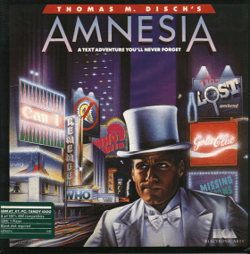Amnesia (video game)
| Amnesia | |
|---|---|
 | |
| Developer(s) | Cognetics Corporation |
| Publisher(s) | Electronic Arts |
| Designer(s) | Thomas M. Disch (Writer) / Kevin Bentley (Programmer) |
| Platform(s) | MS-DOS, Apple II and Commodore 64 |
| Release | 1986 |
| Genre(s) | Text adventure |
| Mode(s) | Single player |
Amnesia is a 1986 text adventure by Cognetics Corporation. It was written by science fiction author Thomas M. Disch and programmed by Kevin Bentley. It was published by Electronic Arts (EA) for DOS and Apple II. A version for Commodore 64 was released in 1987.
Description
The game begins as the player's character awakens in a midtown Manhattan hotel room with absolutely no memory. He has no clothes and no money, and doesn't even remember what he looks like. The player soon discovers he is engaged to a woman he cannot remember, a strange man is trying to kill him, and the state of Texas wants him for murder. From here, the player must unravel the events in his life that led him to this point.
Features
In addition to being a text adventure, the game's major innovation was simulating life in Manhattan. Disch's model covered every block and street corner south of 110th Street. A hard-copy map of the streets and subways of Manhattan was included in the packaging. Players moved from place to place on foot, and had to reach destinations at the correct time of day to initiate plot developments. Stores opened and closed at the correct times, street lights went on, and other aspects of New York City life were simulated. Almost 4000 separate Manhattan locations, including 650 streets, were part of the game. In this aspect, along with the player's freedom of movement (most of the time), Amnesia can be seen as a forerunner of the sandbox game.
Amnesia also featured the ironic, rich writing style of Disch himself, in distinct contrast to the functional or tongue-in-cheek tone of most text adventures. Disch is one of only three major writers (the others being Robert Pinsky, in Synapse Software's Mindwheel (1984) and Douglas Adams, in Infocom's 1987 game Bureaucracy) to create an entirely original feature-length piece of interactive fiction. However, over half of Disch's novel-length manuscript (possibly the largest ever in a major text adventure computer game) had to be cut from the published version due to the storage limitations of the then-current 5¼" floppy disk technology.
Development
Game programmer Kevin Bentley implemented the game using the King Edward Adventure game authoring system, which was developed by James Terry. The game was acquired and produced by Don Daglow.
Impact
One of the last major text-based games published by a major games company other than Infocom, Amnesia is also the only all-text adventure ever published by EA (The Hound of Shadow, released by EA in 1989, also was largely text-based but featured static graphical screens in its displays to establish setting and atmosphere). Although highly praised upon its release for its writing style, the game was only a moderate success.
This can largely be attributed to the game's limited power. The other major publisher of text adventures, Infocom, allowed the player a great deal of freedom. Amnesia, however, constrained the player in many artificial manners. For example, in the opening setting, the hotel room, the phone rings. Though the hotel room door is not locked, the player cannot leave the room. The player must answer the phone in order to proceed. Similar artificial limitations were placed on players as they traversed the game world.
Disch also wrote a screenplay based on the game's characters and story line and it was optioned to one of the major Hollywood studios, but the film was never made.
Reception
A review in Computer Gaming World described the game as being "too much like a novel", giving as example the need to answer the phone in the hotel room. The review also noted the main character would collapse after an unrealistically short amount of time if he didn't eat or sleep frequently.[1] Another writer for the magazine, however, called Amnesia "a brilliant, witty, and intriguing story",[2] and stated that "the text is so rich and the story so interesting that one hardly notices that this is probably the least interactive piece of interactive fiction ever made".[3] Compute! stated that the combination of Disch's writing and Electronic Arts' software "makes Amnesia a text adventure well worth exploring".[4]
References
- ↑ Scorpia (January–February 1987). "Amnesia" (PDF). Computer Gaming World. No. 34. pp. 44–45, 64–65. Retrieved 16 April 2016.
- ↑ Ardai, Charles (December 1986). "Year in Review" (PDF). Computer Gaming World. No. 33. p. 21. Retrieved 16 April 2016.
- ↑ Ardai, Charles (May 1987). "Titans of the Computer Gaming World / Part II of V: Ardai on Electronic Arts" (PDF). Computer Gaming World. No. 37. p. 28. Retrieved 16 April 2016.
- ↑ Trunzo, James V. (May 1987). "Amnesia". Compute!. No. 84. p. 46. Retrieved 9 November 2013.
External links
- Amnesia at MobyGames
- Link to Disch's full manuscript for Amnesia at ascii.textfiles.com
- Amnesia packaging and artwork for Apple IIC with a link to Disch's original manuscript